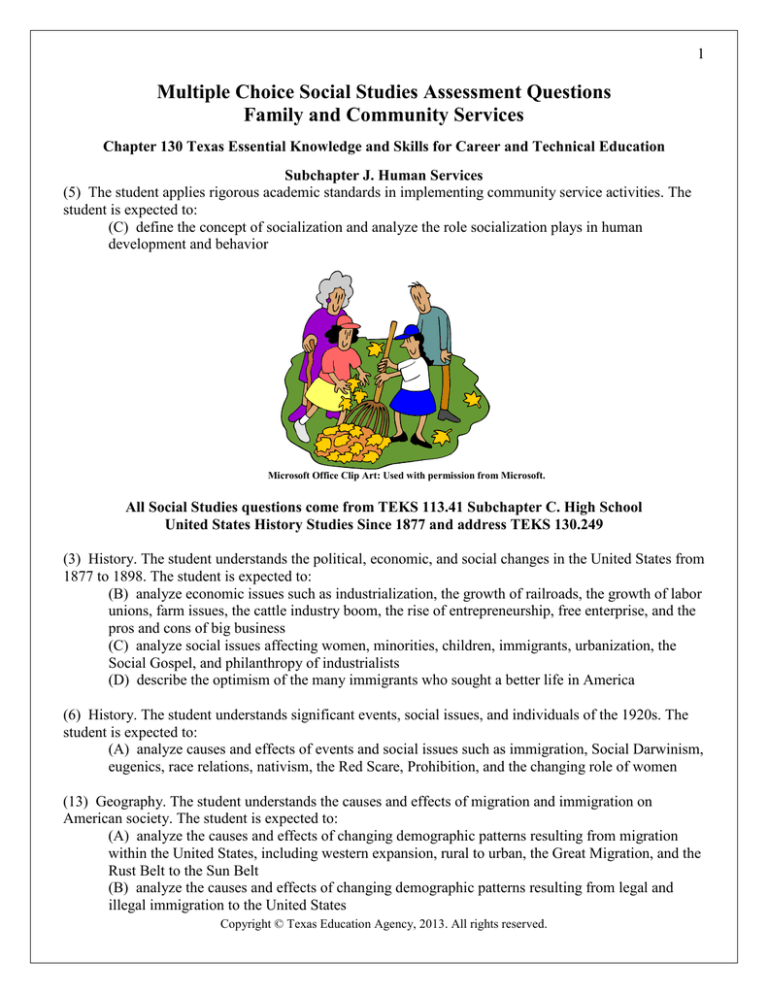
1
Multiple Choice Social Studies Assessment Questions
Family and Community Services
Chapter 130 Texas Essential Knowledge and Skills for Career and Technical Education
Subchapter J. Human Services
(5) The student applies rigorous academic standards in implementing community service activities. The
student is expected to:
(C) define the concept of socialization and analyze the role socialization plays in human
development and behavior
Microsoft Office Clip Art: Used with permission from Microsoft.
All Social Studies questions come from TEKS 113.41 Subchapter C. High School
United States History Studies Since 1877 and address TEKS 130.249
(3) History. The student understands the political, economic, and social changes in the United States from
1877 to 1898. The student is expected to:
(B) analyze economic issues such as industrialization, the growth of railroads, the growth of labor
unions, farm issues, the cattle industry boom, the rise of entrepreneurship, free enterprise, and the
pros and cons of big business
(C) analyze social issues affecting women, minorities, children, immigrants, urbanization, the
Social Gospel, and philanthropy of industrialists
(D) describe the optimism of the many immigrants who sought a better life in America
(6) History. The student understands significant events, social issues, and individuals of the 1920s. The
student is expected to:
(A) analyze causes and effects of events and social issues such as immigration, Social Darwinism,
eugenics, race relations, nativism, the Red Scare, Prohibition, and the changing role of women
(13) Geography. The student understands the causes and effects of migration and immigration on
American society. The student is expected to:
(A) analyze the causes and effects of changing demographic patterns resulting from migration
within the United States, including western expansion, rural to urban, the Great Migration, and the
Rust Belt to the Sun Belt
(B) analyze the causes and effects of changing demographic patterns resulting from legal and
illegal immigration to the United States
Copyright © Texas Education Agency, 2013. All rights reserved.
2
(15) Economics. The student understands domestic and foreign issues related to U.S. economic growth
from the 1870s to 1920. The student is expected to:
(C) explain how foreign policies affected economic issues such as the Chinese Exclusion Act of
1882, the Open Door Policy, Dollar Diplomacy, and immigration quotas
(16) Economics. The student understands significant economic developments between World War I and
World War II. The student is expected to:
(C) analyze the effects of the Great Depression on the U.S. economy and society such as
widespread unemployment and deportation and repatriation of people of European and Mexican
heritage and others
(24) Citizenship. The student understands the importance of effective leadership in a constitutional
republic. The student is expected to:
(A) describe qualities of effective leadership
(26) Culture. The student understands how people from various groups contribute to our national identity.
The student is expected to:
(B) discuss the Americanization movement to assimilate immigrants and American Indians into
American culture
(E) discuss the meaning and historical significance of the mottos "E Pluribus Unum" and "In God
We Trust
Assessment Questions
1. Which action is an example of nativism in the 1920s?
a. widespread violation of Prohibition laws
b. efforts to improve living conditions for Native American Indians
c. passage of laws restricting immigration
d. provision of credit to farmers
2. Nativism in the late 19th century was motivated primarily by
a. hostility toward immigrant workers
b. the need to reduce overcrowding in western states
c. cultural conflicts with Native American Indians
d. the migration of African Americans to northern cities
3. Which was an important cause of immigration to the United States in the 1840”s?
a. the Napoleonic Wars
b. changes in our immigration policy
c. revolutions in Europe
d. completion of the first transcontinental railroad
4. In which period did the largest number of immigrants enter the United States?
a. 1789-1810
b. 1840-1880
c. 1870-1890
d. 1890-1910
Copyright © Texas Education Agency, 2013. All rights reserved.
3
5. Where can an expression of the philosophy of the United States concerning immigration be found?
a. in Washington’s Farewell Address
b. on the base of the Statue of Liberty
c. in the Clayton Act
d. in the Gettysburg Address
6. The Immigration Act of 1965 provided that the United States:
a. retain the national origins system
b. prohibit immigrants from the Western Hemisphere
c. admit more German immigrants
d. give high priority to needed professional people
7. In the early 20th century, immigrants from southern Europe settled chiefly:
a. in the cities of the Far West
b. in the cities along the East Coast
c. on the farmlands in the Midwest
d. on the farmlands of the Far West
8. In the latter part of the 19th century, a liberal immigration policy was generally opposed by:
a. Eastern Manufacturers
b. land speculators
c. labor unions
d. railroad companies.
9. The President’s Council of Economic Advisers is responsible for:
a. preparing the budget
b. analyzing business trends
c. reviewing the work of the independent agencies
d. improving the efficiency of government operations
10. In industries characterized by heavy overhead costs, manufacturers most often seek to:
a. decrease production so as to use less raw materials
b. secure additional money by issuing bonds
c. charge what the traffic will bear
d. increase production to capacity
Copyright © Texas Education Agency, 2013. All rights reserved.
4
Answer Key
1. C
2. C
3. D
4. B
5. C
6. A
7. C
8. A
9. B
10. D
Copyright © Texas Education Agency, 2013. All rights reserved.






